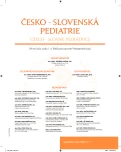-
Medical journals
- Career
A massive pulmonary embolism as a first symptom of nephrotic syndrome in 18-years old female patient
Authors: F. Fencl 1; V. Stará 1; K. Bláhová 1; J. Zieg 1; M. Horáčková 2; M. Pecková 2; J. Charvát 2
Authors‘ workplace: Pediatrická klinika UK 2. LF a FN Motol, Prahapřednosta prof. MUDr. J. Lebl, CSc. 1; Interní klinika UK 2. LF a FN Motol, Prahapřednosta prof. MUDr. M. Kvapil, CSc., MBA 2
Published in: Čes-slov Pediat 2013; 68 (1): 43-48.
Category: Case Report
Overview
The incidence of thromboembolic complications (TEC) in patients with nephrotic syndrome (NS) is about 1.8–5%, but may be underestimated. Most patients with TEC are asymptomatic.
We report a case of an 18-years old female patient on hormonal contraception with irrelevant family and personal history presenting a clinical picture of dyspnea, chest pain, collapse and discrete edemas of eyelids, arms and legs. On echocardiography were indirect signs of pulmonary hypertension, dilation and dysfunction of right ventricle, on ECG was right bundle branch block. At this point, CT-angiography was performed and confirmed the bilateral massive pulmonary embolism (PE). Anticoagulation therapy with heparin and subsequently low-molecular heparin was started. Ultrasound examination focused on detection of the source of embolism was negative, as well the clinical symptoms of previous deep vein thrombosis. Further examinations proved nephrotic proteinuria (6 g/m2/day), biochemical parameters corresponded to NS.
Renal biopsy proved the diagnosis of minimal change NS. Therapy with prednisone was started according to standard protocol with transient effect on proteinuria, during withdrawal of corticosteroids the proteinuria increased again. After that, immunosuppressive therapy with cyclosporine A was initiated.
The NS should be considered in differential diagnoses in patients with PE, all these patients should undergo urine testing for proteinuria. As we demonstrate, massive PE can be rarely the first symptom of NS.Key words:
proteinuria, pulmonary embolism, nephrotic syndrome, minimal change disease
Sources
1. Singhal R, Brimble KS. Thromboembolic complications in the nephrotic syndrome: pathophysiology and clinical management. Thromb Res 2006; 118 (3): 397–407.
2. Llach F. Hypercoagulability, renal vein thrombosis, and other thrombotic complications of nephrotic syndrome. Kidney Int 1985; 28 (3): 429–439.
3. Rabelink TJ, Zwaginga JJ, Koomans HA, Sixma JJ. Thrombosis and hemostasis in renal disease. Kidney Int 1994; 46 (2): 287–296.
4. Crew RJ, Radhakrishnan J, Appel G. Complications of the nephrotic syndrome and their treatment. Clin Nephrol 2004; 62 (4): 245–259.
5. Retzinger GS. Hypercoagulability in the nephrotic syndrome. Lab Lines 2001; 7 (3): 1–2.
6. McPheeters RA, Purcell TB, Snyder DL, Peterson RT. Fatal pulmonary embolism in a 10-year old with nephrotic syndrome. Cal J Emerg Med 2003; 4 (2): 36–38.
7. Jones CL, Hebert D. Pulmonary thrombo-embolism in the nephrotic syndrome. Pediatr Nephrol 1991; 5 (1): 56–58.
8. Bellomo R, Atkins RC. Membranous nephropathy and thromboembolism: is prophylactic anticoagulation warranted? Nephron 1993; 63 (3): 249–254.
9. Kayali F, Najjar R, Aswad F, Matta F, Stein PD. Venous thromboembolism in patients hospitalized with nephrotic syndrome. Am J Med 2008; 121 (3): 226–230.
10. Robert A, Olmer M, Sampol J, Gugliotta JE, Casanova P. Clinical correlation between hypercoagulability and thrombo-embolic phenomena. Kidney Int 1987; 31 (3): 830–835.
11. Mahmoodi BK, ten Kate MK, Waanders F, Veeger NJ, Brouwer JL, Vogt L, et al. High absolute risks and predictors of venous and arterial thromboembolic events in patients with nephrotic syndrome: results from a large retrospective cohort study. Circulation 2008; 117 (2): 224–230.
12. Kerlin BA, Blatt NB, Fuh B, Zhao S, Lehman A, Blanchong C, et al. Epidemiology and risk factors for thromboembolic complications of childhood nephrotic syndrome: a Midwest Pediatric Nephrology Consortium (MWPNC) study. J Pediatr 2009; 155 (1): 105–110.
13. Abul Y, Karakurt S, Ozben B, Toprak A, Celikel T. C-reactive protein in acute pulmonary embolism. J Investig Med 2011; 59 (1): 8–14.
14. Waldman M, Crew RJ, Valeri A, Busch J, Stokes B, Markowitz G, et al. Adult minimal-change disease: clinical characteristics, treatment, and outcomes. Clin J Am Soc Nephrol 2007; 2 (3): 445–453.
15. Janda J, Zabrodsky V, Spatenka J, Tuma S. Thrombosis of the inferior vena cava with successive lung embolization in a 15-year-old boy with the nephrotic syndrome. Padiatr Padol 1986; 21 (2): 177–182.
Labels
Neonatology Paediatrics General practitioner for children and adolescents
Article was published inCzech-Slovak Pediatrics

2013 Issue 1-
All articles in this issue
- Importance of early diagnostics of inherited metabolic disorders in neonatal age
- The influence of menarche of high cholesterol level in adolescent girls with familial hypercholesterolemia
- Somatic development of the child and injury incidence during the pubertal spurt – new knowledge of the correlation between growth dynamics and injury risk in the present population of children
- Analysis of risk factors concerning suicidal behavior in childhood and adolescence
- A massive pulmonary embolism as a first symptom of nephrotic syndrome in 18-years old female patient
- Secondary malignancies in pediatric patients after hematopoietic stem cell transplantation
- Physical activity and addictive diseases: a surprising observation
- Czech-Slovak Pediatrics
- Journal archive
- Current issue
- Online only
- About the journal
Most read in this issue- A massive pulmonary embolism as a first symptom of nephrotic syndrome in 18-years old female patient
- Importance of early diagnostics of inherited metabolic disorders in neonatal age
- Somatic development of the child and injury incidence during the pubertal spurt – new knowledge of the correlation between growth dynamics and injury risk in the present population of children
- Analysis of risk factors concerning suicidal behavior in childhood and adolescence
Login#ADS_BOTTOM_SCRIPTS#Forgotten passwordEnter the email address that you registered with. We will send you instructions on how to set a new password.
- Career

